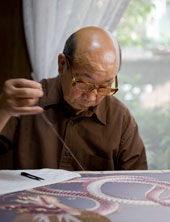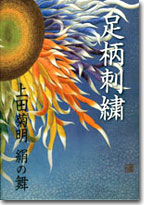Ashigara embroidery Kikuaki Ueda Gallery 1

- The ancient times / early modern embroidery
-
The history of the embroidery is old, and king (AD 283) Chinese Hata Koumano before about 1700 dispatches an engineer of sericulture / texture / nuihaku in Uzumasa, Kyoto as a mission, and it is said when Japan was able to stream down it.
The oldest embroidery to exist in Japan is "Tenjukokushucho" in the Chuguji temple in Nara (AD 623).
In addition, in the Shoso-in magistrate in charge of managing the shogunate's private property, there are many works including "Kajukujyakumonshu", and a work with the connection becomes the subject in Buddhism in old days such as embroidery Buddha or the accessories which did it around the Imperial Court and a temple.
It seems that these things may have dedicated it to a Shinto shrine and a Buddhist temple.
Embroidery was used for outfitting afterwards from Momoyama era.
From the place that I used various threads properly for Kosode and Uchikake, and could express solid magnificence, the people of the upper class let you make these willingly.
Each daimyo seems to hire employed a personal embroidery artisan.
Of the element extremely aristocratic with the thing of world people needing beauty and luxury as for Nuihaku it seems that there was much it.
In the Edo era, a lot of noh costume of the total embroidery was made, and, up to a Furisode and a Fukusa / a Koshiobi / a Koshimaki, it seems to have been a symbol of the best luxury.
The Meiji era began and the people who were a personal embroidery artisan resembled it and came to have a studio.
And such as "tapestry", and "tuitate" "byobu" "sums" high delicate technology of the tone was respected as interior decoration with unpleasant field of the decoration and it was wide and spread for the everyday life of the common people.
Afterwqrds,Foreign culture entered from the Taisho era to the Showa era, and a design / the color took in Western style, too, and technique became delicate.
The war spread and followed afterwards till a ban was given in 1940.
From the end of Meiji to the Taisho era / the Showa era, there is the time when nuihaku prospered as big industry in Odawara.
Nuihaku is a thing peculiar to Ashigara district and makes silk thread twisted thickly ombre dyeing and it is high and puts a core and takes in three-dimensional bold technique.
This stitch was not seen elsewhere, and I was praised to the skies as by Europe and America / each others country, and it was exported from Yokohama Port.
The embroidery wholesale dealers which handled a kimono / a hanten / a gown / a scarf increased in Odawara / Ninomiya / Hadano / Matsuda , and the home side job became popular with this.
It is the wartime like the above, and the order decreases sharply in recession, too and the aging of the engineer is combined, too and is cut off slowly, and it is it with the embroidery of the illusion now afterwards.
I name this embroidery "Ashigara embroidery" daringly in 1982 and reach it at the present.
Kikuaki Ueda

